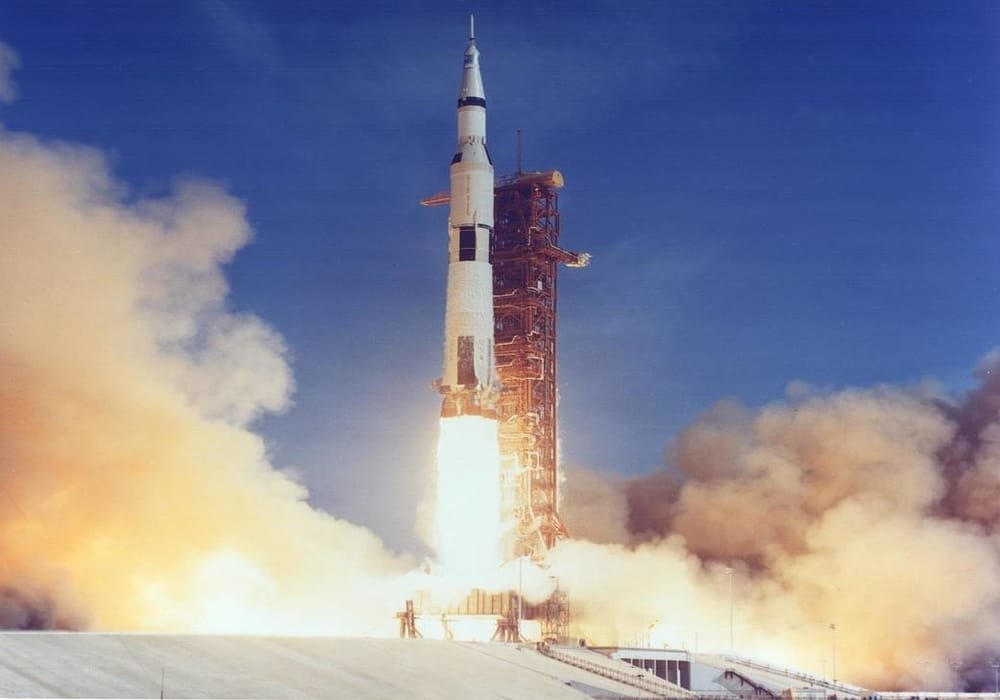Saturn V (Saturn Five)
Saturn V, known as Saturn 5, is a super heavy space launcher developed in the 1960s by the US space agency, NASA, for the Apollo lunar program. Used between 1967 and 1973, it placed in Earth orbit, without any failure, the spaceships which deposited American astronauts on the lunar soil.
The enormous Saturn V rocket launcher from Cape Canaveral and carried three men to the moon. The Apollo 11 mission began…
Cape Canaveral, Wednesday, July 16, 9:32 a.m. local time (3:32 p.m. French time). The Apollo 11 mission is ready for departure. The Saturn V rocket sits on the Pad 39-A launch pad. It is truly gigantic, with more than 110 meters in height (more than twice that of Ariane 6). At its top, a small conical capsule in which are installed three men, Neil Armstrong, Buzz Aldrin and Michael Collins.
Far from the rocket, at the Kennedy Space Center, nearly a million people have been waiting there for hours. On the planet, the number of spectators suspended from radio or television is estimated at nearly 600 million. Never before had any event gathered so many witnesses.
Read also: Apollo 11 first space program men landed on the Moon in 1969
A colossal noise is heard when the five Rocketdyne F1 engines unleash their thrust of 680 tons each. The ground resonates with a seismic wave that propagates up to eight kilometers. Slowly, the 3,000-ton rocket rises in the middle of a huge cloud mainly formed by the condensation of water. The engines then consume 1,800 kilograms of liquid oxygen and 1,700 kilograms of kerosene every second.
As the rocket moves away from the ground, its mass becomes lighter and acceleration increases. It quickly becomes huge. Two minutes after takeoff, Saturn V is just a tiny dot atop a tall white trail, over 50 kilometers above sea level. Now the whole planet knows about it: Men are on their way to the Moon.
On the way to the moon
Two and a half minutes after takeoff, the two thousand tons of fuel contained in the first stage have already gone up in smoke and the enormous cylinder 42 meters high and 10 meters in diameter is dropped. The five J-2 engines (also signed Rocketdyne) light up. The astronauts then undergo an acceleration of 4.5 g (they therefore weigh four and a half times their weight). The second stage (24.8 meters high) maintains this acceleration for five and a half minutes and ensures the exit from the atmosphere. His short mission over, he in turn detaches himself. The three men are then in space.
With its unique J-2 engine, the third stage, nearly 18 meters high, continues to accelerate and is put into orbit, at an altitude of 190 kilometers. The engine is off. Earth’s gravity counterbalanced by centrifugal force, weightlessness (or weightlessness, or, for purists, microgravity) reigns in the capsule. The time to carry out some checks, a few adjustments, to disconnect the oxygen supplies to the spacesuits and to breathe a little, the spacecraft carried out more than two turns of the Earth, at 8 km / s in relation to it.
Read also: ISS Everything you always wanted to know about the International Space Station
Everything is fine. During the third orbit, at 12:16 p.m., the J-2 engine is re-ignited (a possibility that is not obvious for a rocket engine) and the spacecraft accelerates out of orbit. It exceeds 11 km / s. At this speed and at this (low) distance from the Earth, a projectile escapes from the Earth’s attraction. The third stage is off and the spacecraft is now spinning at around 40,000 km / h towards the Moon (unlike Professor Calculus’s rocket which continued to accelerate at 1 g, or nearly 10 m / s more every second).
The crew then ordered the release of protective panels that hid the LM (Lunar Module), called Eagle. The four-legged craft, intended to land on the Moon, sits between the third floor and what was the top of the rocket, that is, the service module (a cylinder with an engine) and the conical capsule (the control module). The LM is in the wrong place. Now you have to bring it where it needs to be, nose to nose with the capsule. Michael Collins is on the move. The service module is detached and rotates on itself to bring the tip of the capsule to face the upper part of the LM. A little push from the attitude motors and the two machines fit together.
The third stage can now be jettisoned, at 12:47 p.m., and a small attitude control motor pushes it away from the rest of the craft. The space train now has its final configuration, the LM (Earth side) attached to the control module, itself integral with the service module (Moon side). The airlock between the LM and the capsule is open, the astronauts can move between the two vessels. They are then 800 kilometers from the surface of our planet. They only have 350,000 kilometers to go…
THE SATURN V LAUNCHER
The complete Saturn 5 launcher with the Apollo spacecraft and the LES ejection tower at the top is 110.6 m high (363 feet or 4318 inches), 10.1 m in diameter at the base and a mass of nearly 3 million kg at launch (2,822,171 kg for Apollo 8 and 2,961,860 kg for Apollo 17) or 12 Boeing 747. The launcher is capable of placing 118,000 kg in Earth orbit or 47,000 kg towards the moon. Its five F1 engines on the first stage develop 3,451,838 kg of thrust (a little less for Apollo 8, 3,401,942 kg) creating a seismic wave felt 8 km around. The second stage is the only one in its category to use hydrogen propulsion.
Nearly 100,000 workers worked on the development, testing and assembly of each launcher. The program required the construction of the largest buildings in the world for the construction, testing, assembly and transportation of the launcher components as well as its payload, the CSM LM Apollo.
CHARACTERISTICS
The Saturn 5 program is the largest project the United States has tackled. In total cost this represents for the production of 15 launchers $ 7 billion until 1970.
Saturn 5 is 110 m high and weighs almost 3,000 tonnes. The first stage, S1C, 42 m long by 10 m in diameter, is powered by five F1 engines with 3,750 tons of thrust. It burns 770,300 liters of kerosene and 1,204,000 liters of oxygen in 2 minutes 30 seconds (150 seconds).
The second stage, S2, is powered by five J2 engines totaling 500 tonnes of thrust. It measures 10 m in diameter and consumes 10,400 liters of liquid hydrogen and 3,320 liters of liquid oxygen in 6 minutes of flight.
The third stage S4B measures 7.6 m in diameter by 17.6 m in length. A frustoconical inter-stage makes it possible to go from a diameter of 10 m to 7 m. When empty, it weighs 170 tonnes and carries 132 tonnes of fuel (LH2 and LOX). Powered by a single J2 engine, it burns for nearly 3 minutes for launching into Earth orbit and 5 minutes for injection to the moon.
The electronic brain, IU is located at the top of the S4B. Weighing 2200 kg, it controls the launcher from launch to lunar injection.
The actual spacecraft consists of the lunar module, LM stored in a frustoconical structure on the third floor, and the CSM Apollo with the cabin and the three astronauts. The LES Rescue Tower tops it off. The whole is 24 m high.
At the end of 1962, after the decision to use LOR to reach the moon, the final configuration of the Saturn 5 was frozen. The Marshall Center oversees it all with NASA. Boeing Cie, the space division of North American Aviation and Douglas Aircraft Cie take care of the first, second and third stages of the launcher. The engines are developed by Rocketdyne. The Marshall center also ensures the development of the UI, subcontracted to IBM. All facilities for production, assembly, testing and launch are prepared by the end of 1962. In anticipation of the enormous work to be done, three sites are created: the Kennedy Center in Florida with the largest shooting complex in the United States. world, the Michoud center in New Orleans for the construction of the floors and the MTF center in St Louis for the ground firing tests.
Saturn 5 is the latest member of the family. It is the biggest rocket in the world. A weight offsetting 19 Boeing 707s (3,038,500 kg), 110 m in height, a payload of 113,000 to 118,000 kg, i.e. 80 Mercury cabins in Earth orbit and 47,000 kg towards the moon. 15 rockets will be built and 13 will be launched from 1967 to 1973. To this are added all the stage models and the 500 F model intended for testing ground installations at the KSC. Today, the various copies are on display in Florida, at the KSC, in Houston at the Johnson Center and in Huntsville at the Marshall Center. Each Saturn 5 costs $ 185 million, or $ 2.5 billion overall. Filling a Saturn 5 requires 56 tank cars for fuel.
Photo explanations: Moon Bound – Apollo 11 Liftoff. The Apollo 11 Saturn V lifts off with astronauts Neil A. Armstrong, Michael Collins and Edwin E. Aldrin Jr. at 9:32 a.m. EDT July 16, 1969, from Kennedy’s Launch Complex 39A. Photo credit: NASA



